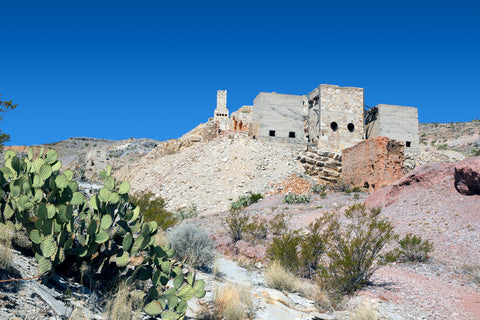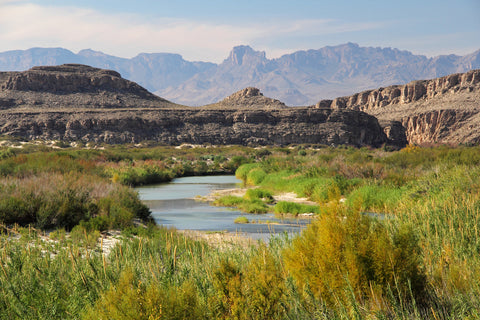Where is Big Bend National Park
In southwestern Texas, along the Mexican border, is Big Bend National Park. The Rio Grande River snakes across the park's southern border. Big Bend US National Park encompasses the entire Chisos Mountain Rage and a sizable section of the Chihuahuan Desert. The Santa Elena Canyon, an iconic feature of Big Bend, was created by the Rio Grande and features dizzying limestone cliffs towering over 1,500 feet. Big Bend National Park is only 20 miles east of Lajitas, Texas. Marathon, Texas is just 42 miles north.

How Big is Big Bend National Park
Big Bend National Park is expansive, covering more than 1,250 square miles - which is bigger than the state of Rhode Island! The park features a Mexican border crossing, sharing a border with Mexico for 118 miles. Big Bend protects the largest section of Chihuahuan Desert in the United States. The highest point in the park is Emory Peak. It stands at an elevation of 7,835 feet above sea level. The lowest point in the park is the Rio Grande at 1,715 feet.
Big Bend National Park Weather
The sun shines brightly in Big Bend, almost year-round. The desert floor is generally much hotter than high in the Chisos. The temperature can vary as much as twenty degrees. Spring (March through May) is warm and inviting. It is the busiest season for the park, especially mid-March. Spring is the start of the rainy season, which is from May through September. Heavy thunderstorms and flash flooding are possible. Summer (June through August) is hot with days often reaching over 100°F. Fall (September through November) is generally dry and clear with an occasional chilly or freezing day. Winter (December-February) brings a variety of conditions, including snow though rare. Holidays are a very busy time at Big Bend, reservations are recommended.
When did Big Bend become a National Park
The land for Big Bend was set aside for the future enjoyment of people in 1944 amidst the disturbance of the Second World War. The area was once seen as too dangerous and remote to be of any use. Spaniards called it "El Despoblado," the uninhabited land. President Franklin D. Roosevelt established Big Bend National Park on June 12, 1944.

Things to do in Big Bend National Park
There are big things to do in Big Bend National Park - much more than can be done in a day! Below is a quick list of the park’s top sights.
Emory Peak
Emory Peak is the highest point in the park, and the 360° view from the summit is incredible. The hike to the peak is rated as strenuous. It is a 10.5-mile round trip. You’ll hike through forest and pass vistas along the way.
Langford Hot Springs
There was once a bathhouse dedicated to the healing properties of the mineral-rich hot springs of Big Bend. While the house is gone, you can still enjoy taking a therapeutic dip in the Langford Hot Springs. The water is naturally and geothermically heated to 105°F.
Santa Elena Canyon
The Santa Elena Canyon was carved by the Rio Grande, leaving a limestone chasm towering more than 1,500 feet. The Canyon straddles the American-Mexican border. There are trails that follow the river on both sides. The canyon is also a popular place for floating.
Ross Maxwell Scenic Drive
This 30-mile drive showcases some of the most impressive geological features and historic sites in Big Bend National Park. The drive will take you to Santa Elena Canyon, Tuff Canyon, Castolon Historic District, and more. There’s also viewpoints and picnic areas along the drive.
Cattail Falls
Even in the desert you can find a waterfall, like Cattail Falls. It’s nestled in the mountains behind Sam Nail Ranch and stands over 80 feet tall. To reach the falls you will need to hike a moderately rated 5.7-mile trail.
Fossil Discovery Exhibit
Look back at 130 million years of history at the Fossil Discovery Exhibit. Over 1200 fossil species have been found in the park. There’s also a picnic site, fossil-themed playground, and a short hiking trail. The trail leads to an overlook of nearby geologic attractions.
Animals in Big Bend
Big Bend National Park is home to many wonderful creatures, most of which are nocturnal to beat the heat, though some are diurnal or crepuscular. Animals you might find out adventuring include bison, bobcat, fox, elk, salamanders, heron, goatsuckers, diamondback rattlesnake, wild burros, and more!
Terlingua Ghost Town
Amid the primitive desert dust, take a step back in time at the Terlingua Ghost Town. Not only can you explore what remains of the settlement, but there are vendors with local arts and food. It’s also a great area for hiking and horseback riding.

Mariscal Mine
In the 1900s, this mine was the bustling center of the Big Bend community. It produced nearly a quarter of America’s mercury. It is now abandoned, with many pieces of the surrounding town still standing. It's a popular site for exploring history, hiking and photography.
Hiking Trails
Big Bend National Park is divided into three zones: river, desert, and mountains. There are more than 150 miles of hiking trails that will take you through it all! From quick and easy day hikes to challenging backpacking trips, there’s a trail for everyone here.

When to go to Big Bend National Park
The best time to go is completely up to you. Like every park, Big Bend has a busy season. Do you want the best weather? Fewer guests? The busiest times for Big Bend are holidays like Spring Break, Thanksgiving, and Christmas. The spring season brings a perfect balance of weather, with average temperatures around 70°F. It is excellent for hiking the lower elevation trails. If you want to spend time in the mountains or on the river, summer is best. However, it gets extremely hot so stay hydrated. Fall has mild temperatures with infrequent rainstorms. Winter is a magical time where the days are cool and the nights are chilly. The end of fall and beginning of winter are busy.
Must-Have things to bring to Big Bend
Make the most of your trip to Big Bend by packing the essentials and leaving the rest. Here are a few items that you won’t want to forget. Our National Parks Visitors Guide suggests the following:
Sun Protection
You’re going to get some sun when you visit Big Bend National Park. It is easy to get sunburned, dehydrated, or worse if you don’t protect yourself. Always wear sunscreen, even if the sky is cloudy. You should also wear sunglasses and a wide-brimmed hat.
Light Layers
The temperature can vary up to twenty degrees between the mountains and the river. The weather can also be a bit unpredictable. The best way to combat the elements is to wear several light layers. A waterproof rain jacket is also a good idea.
Hiking Boots
From the river to the mountains, Big Bend is a rugged and wild place. You will want sturdy hiking boots if you plan on doing any hiking off paved paths. Make sure you wear boots that are already broken in.
Water Shoes
If you plan on playing around the river or doing any floating, you should wear water shoes. Hard-soled water shoes are recommended to protect your feet from sharp rocks, downed trees and other debris that might be in the water.
Park Maps
Don’t waste precious time on your trip being lost, especially in the back-country. Be smart and grab a park map before you head out. You should also grab a trail map of your trail before you start hiking. Find maps at visitor centers and trailheads.

Water
Big Bend is hot and dry, with limited areas supplying drinking water. You will need to bring your own water. Refillable water bottles are preferred over disposable plastic water bottles. You can also bring a hydration filtration system for refilling your water in the wilderness.
Nutrition aka Food, Snacks
While the park serves delicious food, you’ll probably have a hankering for snacks while you’re out hiking. Plus, nothing beats a campfire meal under the stars. If you bring your own food and snacks, be sure to properly store it in bear boxes or canisters.
Bug Spray
Big Bend is home to creatures big and small, including insects. Spring and summer are the worst for bugs like mosquitos, flies, and ticks. Pack or purchase some bug spray (or another insect repellent) to keep these annoying critters off of you and your family.
Day Pack
The best way to carry around the necessities while you’re out on the trails is a day pack (backpack). You’ll want a pack that is lightweight and has plenty of pockets. Being waterproof is a plus. Also bring a first aid kid and a compass.
Flashlight/Headlamp
Big Bend is dark at night! During the dark, you’ll have a magnificent view of the night sky but less so of camp. Save yourself from stubbed toes and lost items. Pack a headlamp or a flashlight. Be sure to bring some extra batteries too.

Where to stay in Big Bend National Park
Staying in Big Bend National Park is one of the best parts! You’ve got a few options too. The Chisos Mountains Lodge is the only lodge in the park. It features full amenities in a cozy setting. These spots fill up fast so book early. There are four developed campgrounds at Big Bend. Some areas require reservations while others don't. If you’re looking to get out into the wilderness, Big Bend offers backcountry backpacking too.
Food Nearby Big Bend
Serving up breakfast, lunch, and dinner with an overlook of stunning scenery is the Mountain View Restaurant. You’ll find it in the Chisos Mountains Lodge featuring a view of the Chisos Basin. It’s the only restaurant in the park. You can get “Hikers Lunches” for picnicking. There are also several areas of the park that offer packaged food and drinks.
Airports near Big Bend National Park
You can’t fly directly to Big Bend National Park but you can get really close. The most convenient commercial airport to use is El Paso International. The closest airport is Midland International. It is about 200 miles from the east entrance. Lajitas Golf Resort has a weekend air service. There are also private airstrips in both Alpine and Lajitas, Texas.

